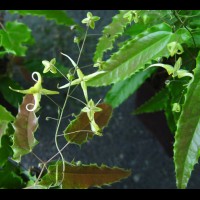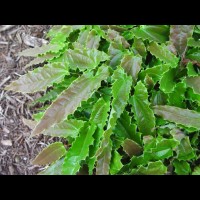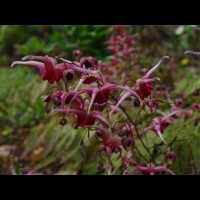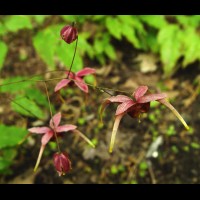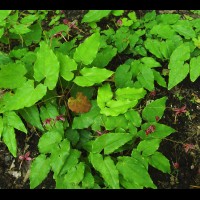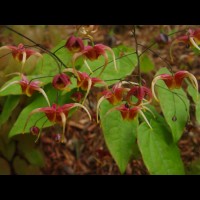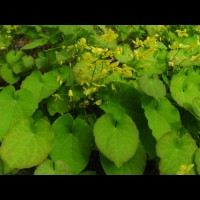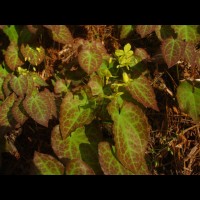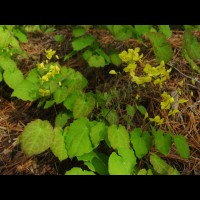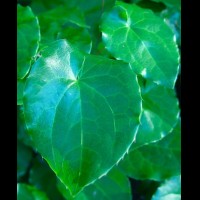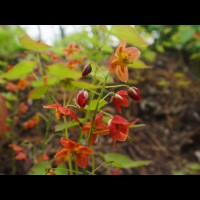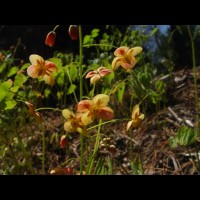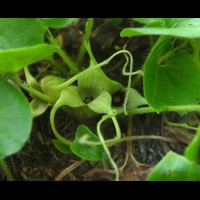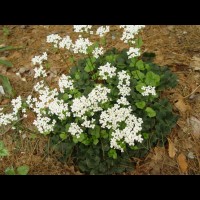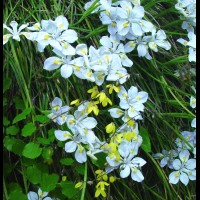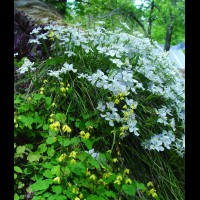Epimedium acuminatum
Epimedium acuminatum (Cc. 930001)
This species was originally collected by Mikinori Ogisu in the late 1970’s, and first introduced into the U.S in 1982. Several new introductions have arrived since, but this clone is the most dwarf at 8-10”. Relatively small evergreen leaflets, bright green in spring with shadows of purple flecks. The large flowers have white inner-sepals and grape-purple petals/spurs. Foliage 8-10" high at maturity.
Epimedium brachyrrhizum
Epimedium brachyrrhizum (Several clones/Cc. numbers)
Discovered in 1994 in Guizhou Province, China, it is one of the shortest species at only 6-8" tall, and among the largest flowered and earliest to bloom, with lavender-pink flowers nearly 2" across! New leaflets may be handsomely mottled with red-maroon in spring. Dark evergreen leaflets have a distinct corrugated surface, and many clones take on maroon overtones in fall. Not available this year.
Epimedium brachyrrhizum 'Karen'
Epimedium brachyrrhizum ‘Karen’ (Cc. 940526)
After years of trialing this plant against other superior forms of E. brachyrrhizum this stands out as the best for its prolific, large flowers in a soft shade of lavender-pink, combined with large leaves, heavily mottled with deep cranberry-rose in the spring. E. brachyrrhizum just happens to be one of my favorite Epimediums, so Darrell named this outstanding clone in my honor. 7” tall. Evergreen.
Epimedium davidii 'Emerald Sheen'
E. davidii ‘Emerald Sheen’ (Cc. 960085)
***2008 Cobblewood™ Introduction***
Extremely glossy leaflets are what makes this clone spectacular. It forms a mass of low growing, shiny foliage with smaller than normal, evergreen leaflets. The new spring foliage is tinted maroon. Flower stems are 12-24” tall with long spikes of many large, rich yellow flowers with tiny red inner-sepals. It is clump-forming, but produces occasional 3–5” rhizomes. Excellent for breeding, in that it passes the sheen of its foliage along to its offspring.
Epimedium davidii "Robust Forms"
E. davidii “Robust Form” (Several clones)
Like many species, E. davidii varies from one location to another. In 1999 Darrell helped to identify Epimediums purchased from China by a local nursery. Overall they were more robust and vigorous than any of the clones that he had collected in China, with flower stems from 18-24” high bearing the typical bright yellow blooms. They also had bolder evergreen foliage than any we have grown. The clones we offer have attractively red-mottled spring leaflets. Spreads slowly by occasional 4-8” rhizomes to form a mass 2’ wide in about 5 years under good growing conditions.
Epimedium dolichostemon
Epimedium dolichostemon Og. 81010 (Cc. 980078)
Narrow, evergreen, medium-sized arrow-shaped leaflets, heavily mottled with burgundy in the spring. Each small uniquely shaped flower has beautiful, reflexed, white inner-sepals and red petals with short, strongly curved spurs. 18” tall. In 1998, Robin White generously shared a blooming plant.
Darrell was awestruck the first time he saw slides of this clone. Lois Himes, garden assistant to Harold Epstein, took them of a plant exhibited by Robin White when she accompanied Harold to a 1995 Royal Horticultural Society show in London. It is far superior to the Ogisu clone (Og. 81011-- which is unfortunately terribly virused) making the rounds in the U.S.
Epimedium epsteinii
E. epsteinii (Several clones/Cc. numbers)
Discovered in 1994 and named after an outstanding plantsman—the late Harold Epstein. For half a century he grew Epimediums to perfection in his garden “La Rocaille” in Larchmont, NY.
This species has the widest sepals in the genus, nearly 1/2" across and slightly longer, pure white and a striking contrast to the reddish-purple spurs and cup. There are 10 (usually) to 30 of these medium-large flowers per stem. 6-10" tall with medium-sized, dark glossy evergreen leaflets. Spreads 6-8" a year forming a dense low groundcover. Benefits from some winter mulch in Zone 5.
Epimedium fargesii
Epimedium fargesii (Several clones/Cc. numbers)
The typical forms of a very choice species and the main target of Darrell’s November 2000 collecting trip to China. He gathered small divisions from a variety of plants at seven locations. 12-18” tall in bloom, with narrow, medium-sized arrow-shaped, dark evergreen leaflets, that persist in the winter garden.
The medium-sized flowers typically have long, white/pale lavender inner-sepals that wrap around smaller, lavender spurs. Often both reflex backwards. Foliage exhibits dark maroon flecking in spring and sometimes fall. First flush 8-10", second growth flush to 15".
Epimedium ilicifolium
Epimedium ilicifolium (Several clones/Cc. numbers)
A particularly cold-hardy, Chinese evergreen species from Shaanxi Province. Darrell found it in three areas in Nov. 2000 at the highest elevation above snowline. He trudged up steep ravines through snow and freezing temps just to see it in the wild. The long, narrow, evergreen leaflets are especially spiny (ilici-=holly, folium=leaf), on stems to 10”. Large flowers with light green inner sepals and bright yellow spurs, on stems to 18”.
Epimedium leptorrhizum Y44
Epimedium leptorrhizum Y44 (Same clone/Sev. Cc. num.)
From Guizhou Province in China, its large light lavender-pink flowers and medium-sized leaves are similar to those of E. brachyrrhizum-- elongated and arrow-shaped, with a corrugated texture. However, it spreads by thin rhizomes that grow 8”+ a year with foliage 6-8” tall. Forms a thick, low evergreen groundcover. Reddish fall color. Evergreen.
Epimedium leptorrhizum 'Hubei Treasure'
Epimedium leptorrhizum ‘Hubei Treasure’ (Cc. 001259)
***2005 Cobblewood Introduction***
Traveling along the Sichuan/Hubei Province border in China on a transitional day between target locations in November of 2000, Darrell stopped to stretch his legs. There he found an Epimedium in the cracks of a short cliff along a farmer’s field. With long hairs on the leaves and long rhizomes, he identified it as E. leptorrhizum, and collected a few samples. Fortunately this clone has larger flowers with near-white spurs backed by rich pink inner sepals, a striking deviation from the typical pale lavender-pink blooms of this species. The evergreen leaves are larger than those of the species. Spreads by 2-4" rhizomes.
Epimedium lishihchenii
Epimedium lishihchenii (Several clones/Cc. numbers)
Collected by NACPEC in 1994 in Hubei Province, China, along with E. stellulatum. Produces large, bold evergreen leaflets that are heavy in substance. One of the few evergreen epimediums where the foliage makes it through many of our harsh winters. The large flowers have green inner-sepals and bright yellow spurs. Hardy to at least Zone 4. Grows to 12” tall. May exhibit various pastel shades in its spring foliage color. Fall color on some clones displays reddish markings on the leaves, as in accompanying photo.
Epimedium macrosepalum
E. macrosepalum (Several clones/Cc. numbers)
An evergreen and drought-tolerant species from the S.E. coastal region of Russia. The flower of this species makes up for its paucity of flowers with their size. The flowers have enormous (for an Epimedium) inner sepals that are a heavenly shade of lavender-pink. Unlike most inner sepals that follow the curve of the spurs, these petaloid structures reflex back like huge rounded wings, arching above the down curving spurs, like an insect taking flight. Both the cup and the tips of the spurs fade to white. Ground hugging foliage 4-8” high is composed of small to medium-sized rounded, heart-shaped leaflets that turn deep maroon over winter. Its low, running habit makes this species a good groundcover. Vigorously spreads by thin 4-12” rhizomes.
Epimedium macrosepalum 'Sweet Rachel'
Epimedium macrosepalum ‘Sweet Rachel’ (Cc. 040102)
***2010 Cobblewood Introduction***
This beautiful, smaller foliaged form has very shiny, bright burgundy leaves in winter if grown in some sun. The ground-hugging, heart-shaped leaves have the texture of the finest leather. Same beautiful, large rose pink flowers as the species and a reliable bloomer, but with very few flowers. Spreads by thin rhizomes which grow from 4-12”a year. From a plant collecting trip Darrell sponsored in cooperation with the U.S. National Arboretum. Drought-tolerant. Evergreen.
Epimedium myrianthum
E. myrianthum (Several clones/Cc numbers)
Although the flowers of E. myrianthum are tiny, with over 100 flowers per stem, they create a billowy mass. White inner-sepals with yellow petals, and iridescent blue-black outer sepals enclosing the flowers in tight bud. Large, glossy, arrow-shaped evergreen spring leaflets are often lightly mottled with maroon. Shadows of that spring foliage mottling often reappear in the cool temperatures of fall. 18-20".
Epimedium myrianthum 'Mottled Madness'
E. myrianthum ‘Mottled Madness’ (Cc. 940110)
***2000 Cobblewood Introduction***
Of all of the plants and seedlings we have grown of this species, this clone stands out for its dark spring coloration. Large leaflets are heavily mottled for a month during spring, like a burgundy form of army camouflage. While the color eventually turns to green, it usually reappears once the temperatures dip in fall, and lasts through the winter in mild climates where the leaves remain evergreen. Bright airy panicles hold tiny white flowers that emerge from iridescently blue-black buds. 8-12”. Native to China.
Epimedium ogisui
Epimedium ogisui (Several clones/Cc. numbers)
Named in 1993 by Professor Stearn after Mikinori Ogisu, who discovered it in China in 1992 growing beside a waterfall. Darrell collected a few divisions at that same waterfall in 1996. Although described as pure white, the inner-sepals are usually pale pink. A cliff dweller in its native habitat, the flower stems spread out nearly horizontally holding large flowers. Medium-sized evergreen leaflets are glaucous, uniquely oval-shaped often with red spring coloration. Spreads by 6-8” long, thin rhizomes. USDA zones 6-9.
Epimedium perralderianum
E. perralderianum (Cc. 980085)
Native to the moist remnants of oak and cedar forest in northeast Algeria, this drought tolerant species forms a handsome evergreen ground cover. Smaller than E. pinnatum ssp. colchicum, it differs in that its heart-shaped, veined leaflets are in sets of three, with spiny edges that give textural interest. Flowers are much the same-- small, lemon-yellow, and rounded with diminutive mahogany spurs that bend upwards. Leaflets are patterned with red/bronze in spring and fall. Spreading rhizomes grow 2-4". First foliage flush to 4", second to 8" high. This clone is courtesy of the late David Barker, who held one of the national UK collections of Epimediums.
Epimedium pinnatum ssp. colchicum
Epimedium pinnatum ssp. colchicum (Sev. clones/Cc. numbers)
Native to the mountainous areas of Georgia along the eastern coast of the Black Sea, this Epimedium is very drought tolerant. A workhorse groundcover for dry areas. Clusters of small, bright yellow flowers are produced on leafless stems above newly emerging leaves. Showy bright yellow inner-sepals back small petals that form a yellow cup. Short reddish spurs are held straight out against the inner-sepals. Spreads 6-8” a year creating a dense growth of large, rounded, shiny, deep evergreen leaflets on stems 8-10”.
Epimedium pinnatum ssp colchicum L321
Epimedium pinnatum ssp. colchicum L321 (Cc. 950222)
This Roy Lancaster collection was obtained from Robin White of Blackthorn Nursery. The dark evergreen leaflets are smaller and narrower than those of the other clones we grow, with a decorative wavy edge, making it a much more open plant, but one with a great deal of textural character. A favorite of mine. Otherwise, it is similar to the other clones. Spreads by 4-6" rhizomes. Drought tolerant.
Epimedium pinnatum ssp. colchicum 'Thunderbolt'
Epimedium pinnatum ssp. colchicum ‘Thunderbolt’ (Cc. 890003)
***2000 Cobblewood Introduction***
Collected in the former USSR Province of Georgia in 1973 by Skip March of the U.S. National Arboretum. We named this clone in cooperation with the Arboretum. Cool autumn temps turn the medium-sized, semi-glossy, evergreen leaflets either dark black/purple or a rich red mahogany, depending on the light exposure. An attractive “thunderbolt” pattern of green main veins overlays the fall color. Flowers have showy bright yellow inner-sepals. 10”. Spreads by rhizomes that grow 6-8” a year making this a great groundcover. Particularly drought tolerant.
Epimedium pinnatum ssp. pinnatum
E. pinnatum ssp. pinnatum (Cc. 980084)
This eastern subspecies of E. pinnatum is uncommon in cultivation. Native to the Caspian forests of northern Iran, the late David Barker shared this with us when we visited his garden in Chelmsford, Essex, UK in 1998. Sprays of small, bright lemon-yellow flowers with tiny brown spurs erupt in early spring to 7” beyond the newly emerging foliage. While the flowers are different from ssp. colchicum in having spurs that are half the length, gardeners will notice the difference in plant habit. Generally taller with 9 medium-sized evergreen leaflets per leaf vs. 3-5. Flowers 3/4” in diameter. Leaflets are a clear spring green with a slight rose flush. Spreads by 8” rhizomes. Light red fall color. The earliest of the E. pinnatums to leaf out in spring.
Epimedium platypetalum
Epimedium platypetalum (Several clones/Cc. numbers)
Native to China, 12 to 15” stems carry 10 to 20 dainty yellow bells suspended like tiny shuttlecocks, backed by tiny, white or reddish inner-sepals. The delicate blooms are held aloft on upright stems rising above small, rounded leaflets. Spreads by 8-12” long rhizomes, forming a low groundcover. Small, rounded, and slightly flecked new spring leaflets have few spines. While evergreen, the leaves flatten in the winter and are not very ornamental during that season. A particularly drought tolerant species.
Epimedium pubescens "Shaanxi Forms"
Epimedium pubescens “Shaanxi Forms”
(Several clones/Cc. numbers)
Epimedium pubescens is generally hardy from Zone 6 south, but these clones from Shaanxi Province have proven hardier, growing well in Zone 5. Forms a leafy clump 12” tall/wide with the flower panicles reaching to 16”. Medium-sized, evergreen spring leaflets are flecked with crimson, and mature to a glossy dark green with spiny margins. Starry flowers are borne in large airy panicles with 1/2” long, narrow, white reflexed inner-sepals and tiny orange-yellow spurred petals. Slightly spreading by 1-2" rhizomes.
Epimedium sagittatum 'Warlord'
E. sagittatum ‘Warlord’ (Cc.021191)
2007 Cobblewood Introduction
A very handsome species, long desired for its exceptionally large, arrow-shaped, evergreen leaflets up to 9” long (in fertile soil and full shade). The spring foliage color of this clone is a spectacular mosaic of various shades of maroon covering the entire leaflet. Side leaflets have exaggerated outer lobes. Tiny flowers with white inner-sepals and golden spurs, are produced in congested panicles of 50 or more against the dark, glossy foliage. Grows to 18” tall here with much more narrow leaflets than the typical species. A slow grower, it forms an impressive clump over time.
Epimedium sp. nov. 'Simple Beauty'
E. sp. nov. ‘Simple Beauty’ (Cc. 022728)
***2010 Cobblewood Introduction***
A new, as yet unnamed, species collected by Darrell in China that is one of his most favorite. It is a simple leaved seedling/clone of a species new to science that normally has 3 leaflets... and VERY rare as Darrell only found a few of them. The very large and simple corrugated evergreen leaves are just about the glossiest of all Epimediums and can reach over 6” long and 2.5” wide. The new spring growth has a slight flush of red with thin needle-like spines along the margins. Flower stems extend 4-5” above the foliage supporting large flowers with long, sulphur-yellow spurs and light green inner-sepals. Its thick, spreading rhizomes grow from 2- 8" a year. It has proven to be a great parent. Photos courtesy of Mark McDonough.
Epimedium sp. nov. 'Spine Tingler'
Epimedium sp. nov. 'Spine Tingler' (Cc. 001764)
***2008 Cobblewood Introduction***
A form of an as yet, unnamed Chinese species collected by Darrell Probst in Sichuan Province. The long, narrow (1”) spiny leaflets emerge with a light chocolate wash in early spring. Later long, overarching stems of large lemon-yellow spidery flowers float over a mass of exceptional evergreen foliage. To 10".
5Epimedium sp. nov. 'Tarantula'
Epimedium sp. nov. ‘Tarantula’ Cc. 012418
This clone has the narrowest leaves of any Epimedium in our entire collection. Delicate hair-like spines, run the edge of each leaf in a zig-zag pattern. Bears long, sprays of soft yellow flowers. Leaflets range in size from .25 to 5/8” across, and 3-4” in length, sporting an occasional simple leaf.
Epimedium stellulatum "Narrow Leaf Forms"
Epimedium stellulatum “Narrow Leaf Forms” (Sev. clones/Cc. #)
NACPEC (North American China Plant Exploration Consortium), is a group of ten botanic gardens and arboreta from across the U.S. and Canada, organized by the National Arboretum to explore areas of China on an annual or semi-annual basis. NACPEC has made several exciting discoveries, including this group of Epimedium stellulatum.
Discovered in several areas in the Qin Ling Shan of Shaanxi Province in 1996, the evergreen leaflets are medium in size, narrower than the original form and have especially spiny margins. 12-18”. The flowers are small white “stars” with tiny yellow petals on long, erect stems held well above the leaves. The floral display is like a miniature constellation suspended above spiny evergreen foliage. Early flowering and long-blooming, 12-18” tall. Hardy to Zone 4, possibly 3.
Epimedium stellulatum 'Wudang Star'
Epimedium stellulatum ‘Wudang Star’ L1193 (Cc. 960139)
Collected in the Wudang-Shan by Roy Lancaster, this clone was the original collection used to describe the species. Plants produce numerous sprays of small, starry-white flowers with minute yellow spurs over spiny, evergreen foliage. The faded maroon-flecked spring leaflets of this clone are much wider and rounded than those of the straight species. 12-18”.
Epimedium sutchuenense
Epimedium sutchuenense (Several clones/Cc. Numbers)
This new Chinese species is from the mountains of southern Shaanxi and northwest Hubei Provinces where it blankets the slopes at approximately 6,000’ elevation. Superficially it resembles E. leptorrhizum, with large, lavender-mauve flowers. Spreads by long, thin 8-12" rhizomes. It produces two leaves on every flower stem, each with three medium-sized, smooth-faced leaflets. Uniformly short at less than 4” tall, it makes an excellent, low, evergreen ground cover.
Epimedium truncatum
Epimedium truncatum (Several clones/Cc. numbers)
The large, evergreen leaflets of E. truncatum differ in that the usual two basal lobes are missing, as if snipped off by scissors! They have a smooth, semi-gloss finish and are held on 15" stems. Open panicles to 21” hold numerous tiny white-sepaled, yellow petaled flowers, covered with striking blue-black outer sepals in bud.
Epimedium wushanense "Spiny leaved forms"
Epimedium wushanense "Spiny Leaved Forms" (Several clones/Cc. numbers)
A beautiful Epimedium with very large, glossy, evergreen leaflets with large spines. Leaflets have good substance and are each up to 6" long, resembling a wildly serrated knife. This extreme spininess of the leaves reveals the relationship of Epimediums to the Barberry family.
Unlike most Epimediums where the individual flowers are spaced so that you can differentiate each bloom, these have abbreviated, congested heads of flowers, reminiscent of a lilac or hydrangea panicle. The large flowers have white sepals and butter-yellow cup and spurs. Unlike the typical E. wushanense, these variants are lower, leafier, with shorter bloom panicles and spread by 4" rhizomes. Many exhibit a black-purple-reddish tinge to the new spring foliage. Plants can reach a height of 12-15" . Spreads slowly.
Epimedium zhushanense
E. zhushanense (Several clones/Cc. numbers)
A new Chinese species, very rare in the trade, discovered near Zhushan and described in 1985. It is similar to E. acuminatum in leaf, flower and its clump-forming habit. The flowers have white or light lavender sepals and deep purple spurs and appear in spring on arching stems. A distinguishing characteristic of its large, evergreen, rough-surfaced spiny leaflets is their wooly undersurface. 8” high.
Epimedium 'Black Sea'
Epimedium ‘Black Sea’ (Cc. 960141)
Prized for its dark, glossy, near-black evergreen winter foliage whose color change is triggered by cool seasonal temperatures. Medium-sized leaflets on 8” stems form a thick groundcover. In spring 14” flower stems rise above the foliage carrying a myriad of small, diaphanous yellow flowers with pale orange veins. Semi-spreading, by 3-5” long rhizomes. An early bloomer, with foliage 12-14" high.
Epimedium 'Buttered Popcorn'
Epimedium ‘Buttered Popcorn’ (Cc. 960040)
***2001 Cobblewood Introduction***
This spontaneous hybrid between E. x setosum and E. davidi appeared in Harold Epstein’s garden in 1996. The plentiful, sunshine-yellow flowers bloom in long, thin sprays, just above the foliage to 15”. The charming small, yellow "box-shaped" flowers have a flared cup with short, sassy spurs and a red rim around the inner-sepals.
Small to medium-sized evergreen leaflets form a mass 10” tall. The leaflets are similar to those of E. davidii, but are longer and narrower, becoming dark green or even black-purple in winter. Grows more vigorously in northern gardens than E. davidii, producing a larger clump in less time.
Epimedium 'Domino'
Epimedium ‘Domino’ (Cc. 990614)
***2004 Cobblewood Introduction***
Absolutely stunning in the garden-- a true specimen epimedium. Long, showy panicles of creamy white flowers with an abbreviated maroon cup are highlighted against handsome mottled foliage in spring. Elegant elongated spring leaflets are sponge-painted in various shades of maroon. Deep reddish-purple outer sepals and dark purple pedicels. Forms a 12-14" mound of spiky evergreen foliage with soft spines, covered in a halo of long flower stems to 16”. May re-bloom and produce a second flush of mottled new growth to 18" under favorable conditions of humus-rich soil and adequate moisture.
Epimedium 'Enchantress'
Epimedium ‘Enchantress’ (Cc. 950021)
A stunning cultivar from Washfield Nursery in England, a result of Elizabeth Strangman’s cross of E. dolichostemon by E. leptorrhizum. Beautiful silvery-pink, medium-sized flowers bloom well above long, narrow, evergreen leaflets (up to 10" in height) with undulating margins. Rhizomes grow 2-4” a year. Reliable deep red fall/winter color.
Epimedium 'Ninja Stars'
Epimedium ‘Ninja Stars’ (Cc. 030301) Plant Patent #29744P2
***2016 Cobblewood Introduction***
A vigorous hybrid of two as yet unnamed, handsome species with particularly nice foliage collected in Sichuan Province, China by Darrell Probst. Long, narrow, very evergreen spiny leaflets form a crown of foliage 10-12” tall. Long sprays of spidery sulphur-yellow flowers scatter above the foliage. The multi-branched, spreading rhizomes grow 4-6” per year. New leaflets display a light bronzy-pink on first and second growth flushes in spring.
Epimedium 'Pink Champagne'
Epimedium ‘Pink Champagne’ (Cc. 990618)
***2007 Cobblewood Introduction***
Perhaps the most all around beautiful Epimedium of those that Darrell has developed so far! Upright, heavy flowered panicles of pink and raspberry flowers float well above handsome, mottled foliage in spring. Medium pink sepals cap the top of each widely-arched spur. From the yellow spur tips that reveal their treasure of nectar, the color changes from white to a rich, berry pink, as if the cup was dipped in raspberry sorbet. Elongated, evergreen medium-sized arrow-shaped leaflets contrast purple mottling against a green background. A vigorous grower, it puts on an incredible show with occasional re-bloom if it is happy in its environment. 12" tall with flower stems reaching 16".
Epimedium 'William Stearn'
Epimedium 'William Stearn' (Cc. 150004)
A hybrid from Robin White of the former Blackthorn Nursery in Hampshire, England. As one of the earliest "red" flowering epimediums, it was named for the late William Stearn who wrote the monograph on Epimediums in 1938 (revised in 2002 by Timber Press).
The arrow-shaped, semi-evergreen leaflets form a handsome clump, exhibiting reddish-brown mottling in the spring. Produces short, few-flowered stems of muddy red and yellow flowers. I have found it to be slow to establish in the garden. The foliage is its greatest asset, in my opinion.
Epimedium x omeiense 'Akame'
E. x omeiense ‘Akame’ Og. 82001 (Cc. 970187)
(Synonyms: ‘Emei Shan’, ‘Rigoletto’)
Mikinori Ogisu collected this clone on Mt. Emei in Sichuan, which Professor Stearn used as the type specimen for his description of E. x omeiense. The brilliant blooms have cherry-red inner-sepals and bright orange and yellow spurs. The cup is most intensely colored and edged in yellow. Open flower sprays are held above large, dark, handsome, glossy sagittate evergreen leaves that sometimes turn maroon in fall. 12-15” tall. A showy late bloomer.
Epimedium x perralchicum
Epimedium x perralchicum
(Several clones/Cc. numbers)
Long confused in the U.S. as its parent, E. perralderianum, (the other being E. pinnatum ssp. colchicum). The floral differences are minor, but the hybrid is more vigorous and hardier, to USDA Zone 4. Large, evergreen leaflets have slightly wavy margins. Like its parents, the leafless stems have small rich yellow flowers reminiscent of Verbascum. Spreads by 4-6” long rhizomes. Leaves form a thick mass 8-10” high. An excellent drought-tolerant groundcover that remains exceptionally evergreen through our harsh New England winters.
E. x perralchicum 'Frohnleiten'
E. x perralchicum ‘Fröhnleiten’ (Cc. 890005)
A drought-tolerant ground cover Epimedium prized for its colorful spring foliage, a gorgeous combination of reddish-bronze over the leaflet with an intricate pattern of green veins. Small, bright yellow flowers. Spreads 4-6” a year with medium/large evergreen leaflets that remain exceptionally evergreen through our harsh New England winters. 12” tall. Blends superbly with yellow-flowered late blooming Narcissus. One of the more common varieties available in the American market, and for good reason.
Epimedium x perralchicum 'Wisley'
Epimedium x perralchicum ‘Wisley’ (Cc. 960041)
A spontaneous hybrid discovered at the Royal Horticultural Society Garden at Wisley, England. Small, bright canary-yellow flowers are produced just above the newly emerging spring foliage to 10”. Medium to large leaflets are dark green with lighter veins and a delicate ruffled edge. The surface of each leaflet is shiny and "puffed" up between the veins, giving it a lustrous, faceted appearance that catches the light. Spreads by 4-6" rhizomes. A great drought-tolerant ground cover with exceptional evergreen leaflets that hold up through most of our harsh New England winters.
Epimedium x warleyense
E. x warleyense (Cc. 890007)
Bright orange flowers make this evergreen sterile hybrid between E. alpinum and E. pinnatum ssp. colchicum unusual. From Miss Willmott’s garden, Warley Place, England. Sprays of small flowers float above rounded, medium-sized, bright green, rounded leaflets. Spreads 5-6" a year with an open growth habit. Foliage to 8”, flowers to 12". Drought-tolerant.
Epimedium x warleyense 'Orangekonigin'
Epimedium x warleyense ‘Orangekönigin’ (Cc. 960140)
A shade or two paler orange than E. x warleyense in bloom, and a top-notch evergreen groundcover, this cultivar was introduced by Ernst Pagels of Germany. The inner-sepals are a soft shade of tangerine traversed by darker orange veins. Shorter rhizomes (2-4") spread to form denser clumps than the straight species, more effectively crowding out weeds. Early bloomer and drought-tolerant. 8-10" tall.
Asarum caudatum forma alba
Asarum caudatum f. alba
A "white” flowered form of this lovely West Coast native ginger. It thrives in partial shade, and moist, humus-rich soil, forming attractive colonies of large, lustrous, dark green, heart-shaped leaves 4” tall. Curious, creamy green flowers, each with three long tails, appear at the base of the plant in spring. This form is not commonly in cultivation and comes true from seed. Spreads by fleshy rhizomes 2-4" per year.
Cardamine trifolia "Japanese Cultivar"
Cardamine trifolia “Japanese Cultivar”
Beautiful, very low growing: 2-3” high, dense and tidy shade ground cover. Purchased in a Japanese garden shop by Barry Yinger with a name he could never find reference to. He believes it is a special selection. It is too nice of a garden plant to let that keep us from offering it.
Clouds of white cruciferous blooms hover 8-10” above the foliage on naked stems in mid-May. Deep evergreen trifoliate leaves with velvety purple undersides. Spreads slowly over time via 2” herbaceous rhizomes. Does best in bright to deep shade, in evenly moist, humus-rich soils. A favorite of mine.
Iris dabashanensis
Iris dabashanensis (Several clones)
(formerly sold under the name Iris henryi)
A newly named Iris species collected by Darrell Probst in N.E. Sichuan Province. Belongs to the same Chinensis section of the genus Iris as I. koreana and odaesanensis, but is very different. Best in bright shade/half-sun and in rock gardens. Forms a 12” by 2’ clump of evergreen, grassy foliage 1/8” wide. In mid-spring, numerous 6” stems emerge, each bearing two 1”+ palest lavender Iris flowers with a small, yellow signal. Pictured here in combination with Epimedium platypetalum.
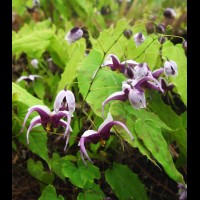
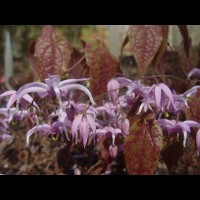
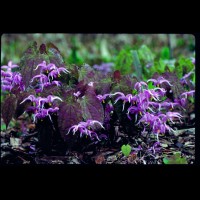
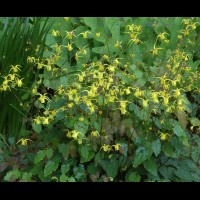
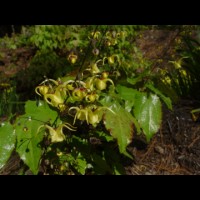
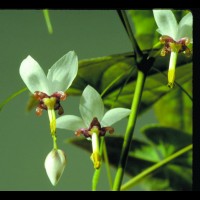
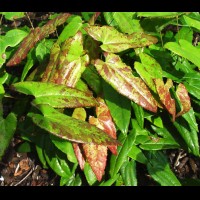
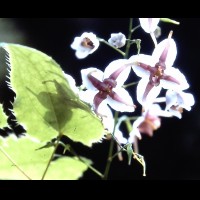
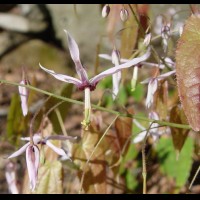
.jpg)
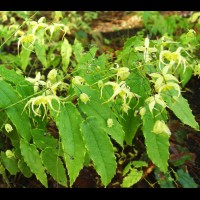

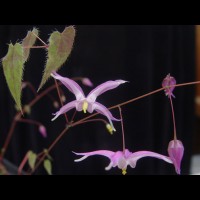
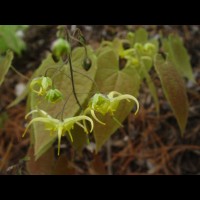
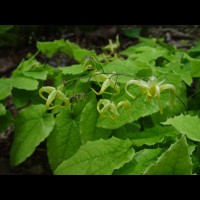
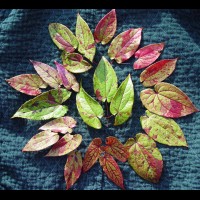
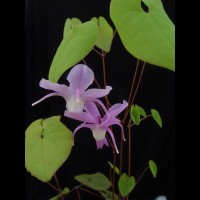
.jpg)

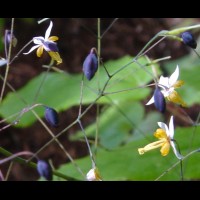
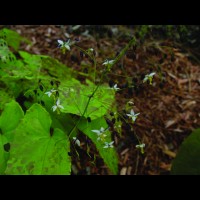
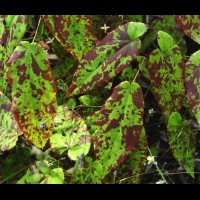
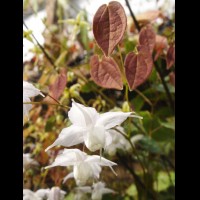
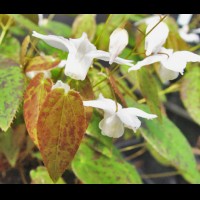
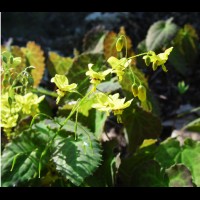
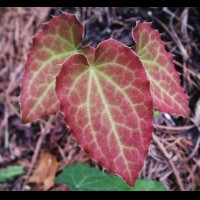
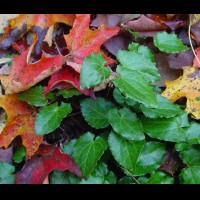
.jpg)
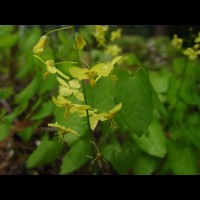
.jpg)
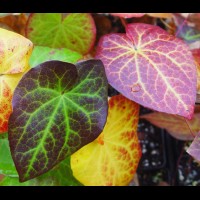
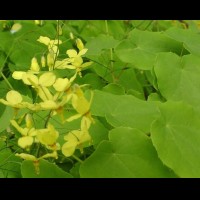
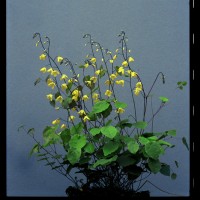
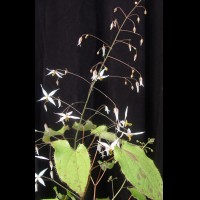
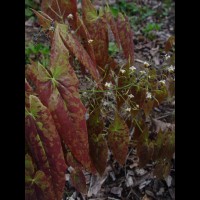
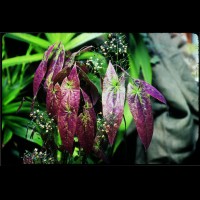
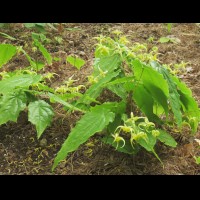
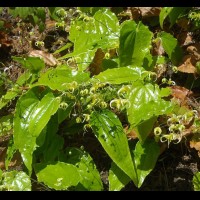
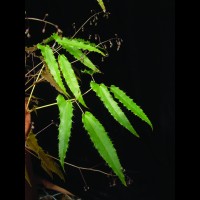
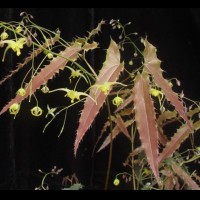
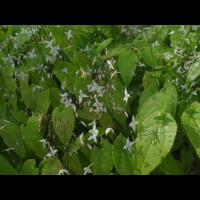
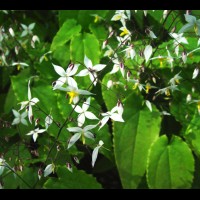
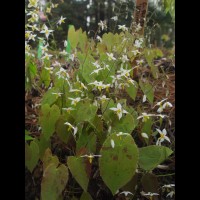
.jpg)
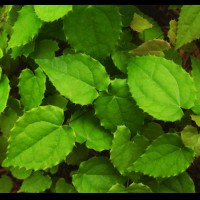
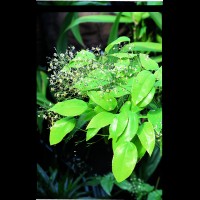
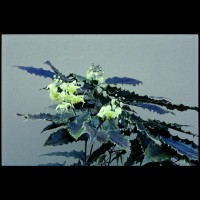
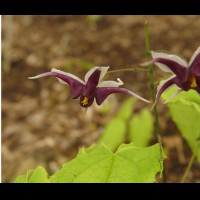
.jpg)
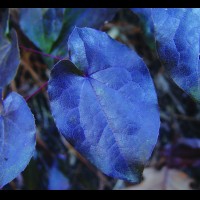
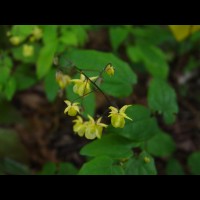
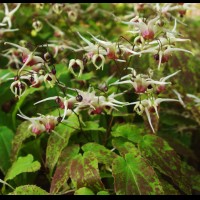
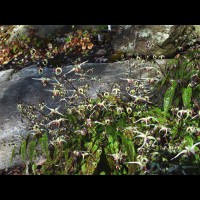
.jpg)
.jpg)

